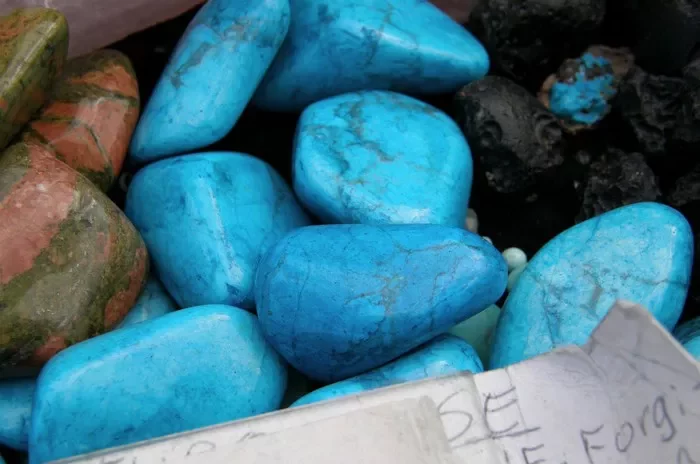Turquoise, with its enchanting hue reminiscent of serene waters and vibrant skies, has captivated civilizations for millennia. Revered by ancient cultures, cherished by artisans, and sought after by collectors, this gemstone continues to fascinate with its mesmerizing beauty. Yet, beneath its alluring surface lies a mystery: What is the true color of turquoise?
To unravel this enigma, one must delve into the geological origins, chemical compositions, and cultural significance of turquoise. Through exploration and analysis, we can discern the essence of this remarkable gemstone and uncover the nuances of its distinctive hue.
Geological Origins:
The journey of turquoise begins deep within the Earth’s crust, where geological processes give birth to this precious gemstone. Turquoise forms through the interaction of copper-rich solutions with porous rock, such as limestone or sandstone, in arid environments. Over millions of years, these interactions create veins and deposits of turquoise within the host rock, waiting to be unearthed by miners and prospectors.
Various regions around the world boast significant deposits of turquoise, each with its unique geological characteristics. From the arid deserts of the American Southwest to the rugged mountains of Central Asia, turquoise emerges as a product of diverse geological phenomena. The nuances of its coloration often reflect the geological conditions under which it formed, ranging from sky-blue to greenish hues.
Chemical Composition:
At its core, turquoise is a hydrous phosphate of copper and aluminum, with traces of iron lending additional coloration. The interplay of these elements within the crystal lattice determines the gemstone’s hue, saturation, and intensity. Copper imbues turquoise with its characteristic blue color, while variations in aluminum and iron content influence the shade and tone of the stone.
The presence of other minerals, such as limonite or manganese, can introduce subtle shifts in color, giving rise to the diverse spectrum of turquoise shades observed in nature. From the vivid blues of Persian turquoise to the earthy greens of Nevada turquoise, each variation reflects the unique chemical makeup of its geological environment.
Cultural Significance and History:
Turquoise has played a significant role in various cultures throughout history, revered for its beauty and believed to possess mystical properties. Some of its notable cultural associations include:
Ancient Egypt: Turquoise was used in ancient Egypt for decorative purposes, with inlaid turquoise found in grave furnishings dating back to around 3000 BCE. It was associated with protection and was often used in amulets and jewelry.
Ancient Persia: In the ancient Persian Empire, turquoise was believed to protect against unnatural death. It was highly prized and often used in jewelry and ceremonial objects.
Native American Cultures: Turquoise holds a special significance in many Native American cultures, where it is considered a sacred stone representing wisdom, protection, and healing. It is often used in jewelry and ceremonial objects.
Islamic Architecture: Turquoise is a prominent color in Islamic art and architecture, often seen in the intricate tile work of mosques and palaces. It symbolizes heaven, spirituality, and immortality.
Color Variations:
Turquoise comes in a variety of shades, each with its own distinct charm. From the delicate hues of “robin’s egg blue” or “sky blue” to the deeper tones of dark turquoise, there’s a shade to suit every taste and occasion. Some of the common variations include:
Medium Blue: Often likened to the color of robin’s eggs or the vast expanse of the sky, medium blue turquoise exudes a sense of tranquility and serenity.
Celeste: A lighter shade of turquoise, reminiscent of the clear blue skies on a sunny day.
Light Turquoise: Deeper than celeste yet still vibrant, light turquoise adds a touch of sophistication to any setting.
Dark Turquoise: Rich and luxurious, dark turquoise commands attention with its depth and intensity.
Bright Turquoise: Vivid and striking, bright turquoise is perfect for making a bold statement.
The True Color of Turquoise: A Matter of Perception
Despite its widespread admiration, determining the true color of turquoise remains a subjective endeavor. The perception of color is influenced by factors such as lighting conditions, impurities within the gemstone, and individual preferences. What may appear as a rich Persian blue to one observer might be interpreted as a softer aquamarine by another.
Moreover, the treatment and enhancement of turquoise can further complicate matters, as techniques such as stabilization and dyeing may alter its natural coloration. While these practices aim to enhance the gemstone’s beauty and durability, purists argue that they detract from the authenticity and intrinsic value of turquoise.
In the quest to uncover the true color of turquoise, we must embrace the diversity and complexity of this remarkable gemstone. From its geological origins to its cultural significance, turquoise embodies a rich tapestry of history, artistry, and natural beauty.
Whether admired for its vivid blues, verdant greens, or subtle variations in between, turquoise continues to enchant and inspire generations of admirers. As we gaze upon the mesmerizing hues of this timeless gemstone, let us appreciate not only its outward beauty but also the stories and secrets it holds within.
In the end, perhaps the true color of turquoise lies not in its physical properties but in the emotions and memories it evokes in those who behold its splendor. And in that sense, its true color is as boundless as the imagination itself.


